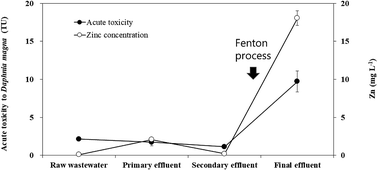当前位置:
X-MOL 学术
›
Environ. Sci.: Processes Impacts
›
论文详情
Our official English website, www.x-mol.net, welcomes your
feedback! (Note: you will need to create a separate account there.)
Effect of low-purity Fenton reagents on toxicity of textile dyeing effluent to Daphnia magna
Environmental Science: Processes & Impacts ( IF 4.3 ) Pub Date : 2017-07-06 00:00:00 , DOI: 10.1039/c7em00078b Joorim Na 1, 2, 3, 4 , Jisu Yoo 1, 2, 3, 4 , Gwiwoong Nam 1, 2, 3, 4 , Jinho Jung 1, 2, 3, 4
Environmental Science: Processes & Impacts ( IF 4.3 ) Pub Date : 2017-07-06 00:00:00 , DOI: 10.1039/c7em00078b Joorim Na 1, 2, 3, 4 , Jisu Yoo 1, 2, 3, 4 , Gwiwoong Nam 1, 2, 3, 4 , Jinho Jung 1, 2, 3, 4
Affiliation

|
This study aimed to identify the source of toxicity in textile dyeing effluent collected from February to July 2016, using Daphnia magna as a test organism. Toxicity identification evaluation (TIE) procedures were used to identify the toxicants in textile dyeing effluent, and Jar testing to simulate the Fenton process was conducted to identify the source of toxicants. Textile dyeing effluent was acutely toxic to D. magna [from 1.5 to 9.7 toxic units (TU)] during the study period. TIE results showed that Zn derived from the Fenton process was a key toxicant in textile dyeing effluent. Additionally, Jar testing revealed that low-purity Fenton reagents (FeCl2 and FeSO4), which contained large amounts of Zn (89 838 and 610 mg L−1, respectively), were the source of toxicity. Although we were unable to conclusively identify the residual toxicity (approx. 1.4 TU of 9.71 TU) attributable to unknown toxicants in textile dyeing effluent, the findings of this study suggest that careful operation of the Fenton treatment process could contribute to eliminating its unintended toxic effects on aquatic organisms.
838 and 610 mg L−1, respectively), were the source of toxicity. Although we were unable to conclusively identify the residual toxicity (approx. 1.4 TU of 9.71 TU) attributable to unknown toxicants in textile dyeing effluent, the findings of this study suggest that careful operation of the Fenton treatment process could contribute to eliminating its unintended toxic effects on aquatic organisms.
中文翻译:

低纯度芬顿试剂对纺织印染废水对水蚤的毒性作用
这项研究旨在确定以大型蚤(Daphnia magna)为测试生物的2016年2月至2016年7月收集的纺织印染废水的毒性来源。毒性鉴定评估(TIE)程序用于鉴定纺织品印染废水中的有毒物质,并进行了模拟Fenton工艺的Jar试验以鉴定有毒物质的来源。在研究期间,纺织品染色废水对D. magna急性毒性很大(从1.5到9.7毒性单位(TU))。TIE结果表明,芬顿法衍生的锌是纺织印染废水中的关键毒物。此外,Jar测试还表明,低纯度的Fenton试剂(FeCl 2和FeSO 4)含有大量的锌(89 分别是838和610 mg L -1)。尽管我们无法最终确定纺织品染色废水中的未知毒性所致的残余毒性(约1.4 TU,约合9.71 TU),但这项研究的发现表明,芬顿处理工艺的仔细操作可能有助于消除其意外的毒性作用在水生生物上。
分别是838和610 mg L -1)。尽管我们无法最终确定纺织品染色废水中的未知毒性所致的残余毒性(约1.4 TU,约合9.71 TU),但这项研究的发现表明,芬顿处理工艺的仔细操作可能有助于消除其意外的毒性作用在水生生物上。
更新日期:2017-09-20
 838 and 610 mg L−1, respectively), were the source of toxicity. Although we were unable to conclusively identify the residual toxicity (approx. 1.4 TU of 9.71 TU) attributable to unknown toxicants in textile dyeing effluent, the findings of this study suggest that careful operation of the Fenton treatment process could contribute to eliminating its unintended toxic effects on aquatic organisms.
838 and 610 mg L−1, respectively), were the source of toxicity. Although we were unable to conclusively identify the residual toxicity (approx. 1.4 TU of 9.71 TU) attributable to unknown toxicants in textile dyeing effluent, the findings of this study suggest that careful operation of the Fenton treatment process could contribute to eliminating its unintended toxic effects on aquatic organisms.
中文翻译:

低纯度芬顿试剂对纺织印染废水对水蚤的毒性作用
这项研究旨在确定以大型蚤(Daphnia magna)为测试生物的2016年2月至2016年7月收集的纺织印染废水的毒性来源。毒性鉴定评估(TIE)程序用于鉴定纺织品印染废水中的有毒物质,并进行了模拟Fenton工艺的Jar试验以鉴定有毒物质的来源。在研究期间,纺织品染色废水对D. magna急性毒性很大(从1.5到9.7毒性单位(TU))。TIE结果表明,芬顿法衍生的锌是纺织印染废水中的关键毒物。此外,Jar测试还表明,低纯度的Fenton试剂(FeCl 2和FeSO 4)含有大量的锌(89
 分别是838和610 mg L -1)。尽管我们无法最终确定纺织品染色废水中的未知毒性所致的残余毒性(约1.4 TU,约合9.71 TU),但这项研究的发现表明,芬顿处理工艺的仔细操作可能有助于消除其意外的毒性作用在水生生物上。
分别是838和610 mg L -1)。尽管我们无法最终确定纺织品染色废水中的未知毒性所致的残余毒性(约1.4 TU,约合9.71 TU),但这项研究的发现表明,芬顿处理工艺的仔细操作可能有助于消除其意外的毒性作用在水生生物上。











































 京公网安备 11010802027423号
京公网安备 11010802027423号